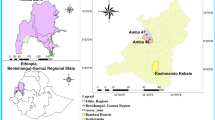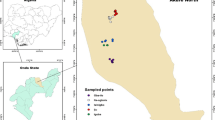Abstract
The mosquitoes are small dipteran insect vectors responsible for various diseases like malaria as one of the major health problem that causes enormous mortality and morbidity in tropical and subtropical countries. The breeding habitat of mosquitoes is crucial for its population dynamics, since it is the location where many important life cycle processes occur such as oviposition, larval development, and emergence of the adult take place. The present study depicted the spatial distribution of anopheline larval (Anopheles subpictus) habitats using GIS mapping in malaria prone blocks of Hooghly district, West Bengal, India. Physico-chemical parameters like pH, dissolved oxygen content, turbidity, alkalinity, total dissolved solids and chloride content in relation to the larval prevalence of various breeding habitats were recorded during the study period (from Dec’2015 to Nov’2016). The present investigation showed the correlation between the physico-chemical parameters and anopheline larval abundance to be considered as a key factor for taking effective management programme to combat malaria .




Similar content being viewed by others
References
Porter AG, Elizabeth WD, Liu JW (1993) Mosquitocidal toxins of bacilli and their genetic manipulation for effective biological control of mosquitoes. Microbiol Mol Biol Rev 57(4):838–861
Cook GC, Zumla A (2003) Hanson’s tropical diseases, 21st edn. WB Saunders Co., Ltd., London
Poopathi S, Tyagi BK (2006) The challenge of mosquito control strategies: from primordial to molecular approaches. Biotechnol Mol Biol Rev 1(2):51–65
Trape JF, Pisson G, Spiegel A, Enel C, Rogier C (2002) Combating malaria in Africa. Trends Parasitol 18(5):224–230. https://doi.org/10.1016/S1471-4922(02)02249-3
Chatterjee SN, Chandra G (2000) Role of Anopheles subpictus as a primary vector of malaria in an area in India. Jpn J Trop Med Hyg 28(3):177–181
Ghosh KK, Chakraborty S, Bhattacharya S, Palit A, Tandom N, Hati AK (1985) Anopheles annularis as a vector of malaria in rural West Bengal. Ind J Malariol 22:65–69
Walker K, Lynch M (2007) Contributions of Anopheles larval control to malaria suppression in tropical Africa: review on achievements and potential. Med Vet Entomol 21:2–21
Becker N, Petrić D, Zgomba M, Boase C, Dahl C, Madon M, Kaiser A (2010) Mosquitoes and their control. Springer, Berlin
IndiaMapia. Pandua (West Bengal) Map. http://www.indiamapia.com/Hooghly/Pandua.html. Accessed 2017
Inmap.in. Information About Sarai-tinna Pandua Hooghly West Bengal. http://inmap.in/Sarai-tinna/Pandua/Hooghly/West Bengal. Accessed 2017
World Health Organization (1992) Lymphatic filariasis, the disease and its control. Fifth report of the WHO Expert Committee on Filariasis. WHO Tech Rep Ser 821:1–31
Service MW (1983) Mosquito ecology: field sampling methods. Applied Science Publishers, London
Service WM (1993) Mosquito ecology: field sampling methods. Chapman and Hall, London, pp 1–988
Reid JA (1968) Anopheles mosquitoes in Malaysia and Borneo. Institute for Medical Research, Kuala Lumpur, p 520
American Public Health Association (2005) Standard methods for the examination of water and wastewater, 21st edn. American Public Health Association, Washington, DC
Nagpal BN, Sharma VP (1995) Indian Anophelines. Science Publishers, New York
Olayemi IK, Omalu IC, Famotele OI, Shegna SP, Idris B (2010) Distribution of mosquito larvae in relation to physicochemical characteristics of breeding habitats in Minna, North Central Nigeria. Agriculture 1:49–53
Ahmadi SM, Vatandoost H, Zare M (2014) Characterization of larval habitats for anopheline mosquitoes in a malarious area under elimination program in the southeast of Iran. Asian Pac J Trop Biomed 4(1):S73–S80
Norkuti M (2014) The effect of abiotic and landscape features on abundance of Anopheles larvae. Independent project/Degree project/SLU, Department of Ecology
Chirebvu E, Chimbari JM (2014) Characteristics of Anopheles arabiensis larval habitats in Tubu village, Botswana. J Vector Ecol 40(1):129–138
Emosairue EO, Theodora I, Ogharanduku T, Nmor JC (2015) Oviposition site selection and habitat characterization of Anopheles Mosquito in Abraka, Delta State, Nigeria. IJTDH 7(3):109–118
Symes CB (1932). Notes on the infectivity, food and breeding waters of anophelines in Kenya. Rec. Mea, Res. Lab. Kenya No. 4:28
Mosna E (1937) The natural history of mosquitoes. The Macmillan Co, New York, p 379
Chatterjee S, Chakraborty A, Sinha KS (2015) Spatial distribution & physicochemical characterization of the breeding habitats of Aedes aegypti in & around Kolkata, West Bengal, India. Indian J Med Res 142:79–86
MacGregor ME (1972) Mosquito surveys. Welcome Bureau of Scientific Research, London, p 282
Woodhill AR (1938) Salinity tolerance and pH range of Cx. futigans with notes on the anal papillae of salt water mosquitoes. Proc Linn Soc NSW 63:273–281
Awolola TS, Oduola AO, Obansa JB, Chukwurar NJ, Unyimadu JP (2007) Anopheles gambiae s.s. breeding in polluted water bodies in urban Lagos, southwestern Nigeria. J Vector Borne Dis 44:241–244
Acknowledgements
The authors are thankful to PURSE, DST FIST, The University of Burdwan for providing the infrastructure to carry out the work.
Author information
Authors and Affiliations
Corresponding author
Ethics declarations
Conflict of interest
The authors declare that they have no conflict of interest.
Additional information
Significance Statement
Present investigation embodied the breeding habitat characterization of malarial vector along with the application of GIS as a more reliable and accurate method to properly identify the mosquitogenic conditions, mosquito breeding grounds, larval density to build up an alternative strategy to suppress the vector and malaria transmission.
Rights and permissions
About this article
Cite this article
Seal, M., Pahari, D., Saha, N.C. et al. GIS Mapping and Breeding Habitat Characterization of Anophelines Occurring in Malaria Endemic Areas of Hooghly, WB, India. Proc. Natl. Acad. Sci., India, Sect. B Biol. Sci. 89, 657–670 (2019). https://doi.org/10.1007/s40011-018-0981-1
Received:
Revised:
Accepted:
Published:
Issue Date:
DOI: https://doi.org/10.1007/s40011-018-0981-1




